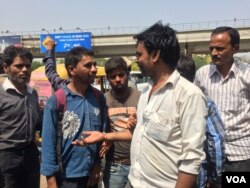Like thousands of other small-business entrepreneurs in India, Charanjit Yadav saw his sales of generator sets and batteries plummet in the weeks after the government's surprising move to scrap 86 percent of the country's currency last November.
Six months on, as business booms, Yadav only recalls the currency ban when he looks at the crisp new notes that have replaced the old ones. "Everything is back to normal. It is absolutely OK for my work," he said, glancing at the orders placed on another busy day.
But less than a kilometer from the bustling market where his shop is located in the business hub of Gurugram, near New Delhi, the massive cash crunch that India faced for more than two months has left its mark.
Braving sizzling summer temperatures of 44 degrees C (111 degrees F), a group of construction laborers had waited since dawn at a junction where contractors normally come to hire daily wage workers.
Fewer opportunities
Dhani Ram left for his village in January after work dwindled as cash shortages stopped many real estate projects. He returned a month ago, hoping that finding work would be easier. That has not happened.
"I hardly get work for 15 days in a month," he said. "Earlier, I used to get work for about 25 days a month."
Unable to eke out a living from his tiny farm in Uttar Pradesh state, Gajinder Singh and 11 others in his village came to the city with a contractor who promised them work. But after four days, he had not been placed anywhere.
"I sleep at night under the rail station, I don't know what to do," he said in despair.
Six months after India's fast-growing economy was disrupted by the radical currency ban, growth is back on track in most sectors and stock markets are surging. But many poor people still scramble to find work as the country's vast informal sector continues to struggle.
Growth last year is estimated to have been around 7 percent — less than the 7.9 percent recorded in the previous year, but not as severely dented as many economists had feared. Indian officials say these numbers give the lie to grim warnings that the drastic move, meant to flush out untaxed money, would put a grinding brake on the economy.
"It was clearly not doomsday. Looks like it was a blip, a banknote blip," said chief economist D.K. Joshi at Crisil research and consultancy in Mumbai.
Auto sales jump
Many indicators support that. Automobile sales have jumped in recent months as serpentine lines outside banks to exchange old notes vanished. Automakers have lined up new launches as shoppers again open their purses.
Projections that the economy is poised for stronger growth has led stock markets to hit a record high in the past week. The rally has drawn tens of thousands of new middle-class investors into the market amid optimism that growth is rebounding.
Economists say most sectors of the economy are back to normal except those that depend heavily on cash transactions, such as real estate.
N.R. Bhanumurthy at the National Institute of Public Finance and Policy in New Delhi said it would take more time to assess the full impact of the currency ban on the economy. But he said he was optimistic it did not erode confidence as was widely feared.
He pointed to India's strengthening currency — the rupee is at a nearly two-year high and has gained about 5 percent against the dollar in recent months.
"While other currencies in the world are depreciating because of the strengthening of the U.S. dollar, ours is the only major currency that is appreciating. So that shows that the foreign investor seems to be betting heavily on the Indian growth story," he said.
'Devastating' for many
However, while it is largely business as usual for the middle class and formal sectors, economists say the impact on tens of millions of people who depend on the informal sector — hawkers, vegetable sellers and laborers in cities and small farmers in remote villages — has been much harder. India's informal sector accounts for 40 percent of gross domestic product but employs as much as 75 percent of the country's workforce.
Calling the move "devastating" for the informal sector, economist Kaushik Basu wrote this week in the Indian Express newspaper that "the brunt of the pain of demonetization has been shouldered by the poor and the lower middle class."
While the full impact on them may not yet have been reflected in statistics, the mood of despondency among those waiting for work in Gurugram gave support to such assessments.











